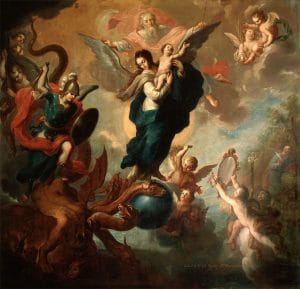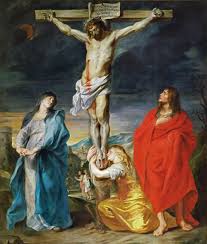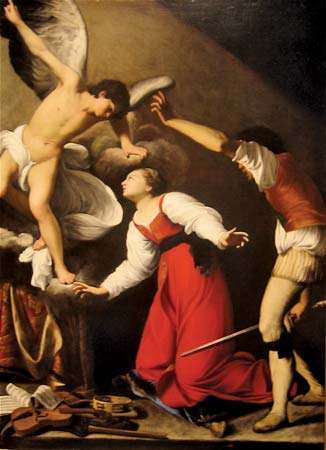In 1926, Our Lord appeared to the last surviving Fatima visionary, Sr. Lucia, in order to ask her to spread the First Saturday Devotion. In particular, He wanted the Faithful to fervently offer reparation for the blasphemies committed against the Immaculate Heart of Mary. Of special concern were blasphemies committed by those who “publicly implant in the hearts of children indifference, disrespect, and even hate against the Immaculate Mother.” This wave of indifference and disrespect is fueled mostly by those who attempt to reduce Mary to the point that she is just like the rest of us. We must oppose this tendency of what most aptly be called “over-naturalizing” Our Lady to the point of diminishing the transformative power of supernatural grace.
One way we can combat this is to highlight those areas of her spiritual life that were markedly different from us. A good place to start is with Our Lady’s experience of temptations. The reductionist says Our Lady suffered temptations just like the rest of us. We might not know for sure whether or not she was tempted but we can say with assurance that her experience would have been profoundly different from our own.
On Being Tempted
Traditionally understood, temptations have their origin in three sources—the Devil, the World and the Flesh. The Devil’s temptations take the form of suggestions to us. They “arise from those things towards which each one has an inclination” (ST III q. 41, art. 4). This means that he can “see” what we are inclined towards at a given time and then suggest to us to act upon that inclination in a disordered way. As an example, when Our Lord was fasting in the desert we are told “He was hungry” and so Satan tempts Him first by trying to take advantage of his hunger.
With Our Lord, the inclination towards food was natural and not disordered in any way. For the rest of us, we have disordered inclinations that fall broadly into the categories of the World and the Flesh. These both come about as a result of the wounding of Original Sin. The World represents inordinate attachments to the things of this world to varying degrees. It is a tendency to look upon the things that are made and not seeing the One Who made them. Likewise, when we speak of the Flesh, we mean an inordinate love of sensual pleasure that manifests itself either in a horror of suffering or an insatiable desire for pleasure.
While the Devil is active in tempting us by taking advantage of these inclinations, not all our temptations come from him. These inclinations are “natural” in our fallen state and thus we can succumb to them without any instigation. This is the “sin” that acts like “a law of my members” that St. Paul tells the Romans is constantly at war with his inward man (Romans 7:19-23).
Our Lady and Temptations
Our Lady then, because she was singularly privileged to be conceived without Original Sin, experienced temptations differently than we do. She did not experience temptations from the Flesh or from the World. In other words, she could only experience temptations that were suggested to her by the Devil. The question then is whether she did in fact experience these temptations.
We must admit that Scripture is silent, at least explicitly, as to whether she was tempted or not. But there is at least enough implicit data to suggest that Our Lady was in fact tempted by the Devil.
First, there is the principle of typology by which the archetype is always greater than the type. Because the Old Eve was tempted by the Devil and fell, the New Eve must also be tempted by the Devil and overcome him.

Second, there is the promise of the Protoevangelium (Gn 3:15) by which the New Eve, animated by a spirit of enmity, shall bruise the head of the ancient serpent. This suggests not just a passive role, but a personal one by which she engages the Devil in a one-on-one fashion.
Our Lady’s hand-to-hand combat is described in Revelation 12:13-17. It presents the devil as relentless in pursuit of her by which he tries to sweep her away in a flood of temptations, but God continually comes to her aid by swallowing up the waters of temptation. Inserting temptations into the narrative may seem like a stretch until we read in verse 17 where the serpent grew angry at the Woman and went off to wage war on the rest of her children. The devil’s primary weapon in that war is temptation.
Why This Matters
People are often annoyed by speculative questions like this because they seem too “scholastic”. But the purpose of speculative questions in theology is to affect us in the practical realm. St. Thomas in the already quoted question in the Summa (III q.41) on Christ’s temptation in the desert tells us that there are two kinds of temptations. First there are those whose origin are the World and the Flesh. These we should flee as near occasions of sin. The other are those that come from the Devil. Aquinas says:
“[S]uch occasions of temptation are not to be avoided. Hence Chrysostom says: ‘Not only Christ was led into the desert by the Spirit, but all God’s children that have the Holy Ghost. For it is not enough for them to sit idle; the Holy Ghost urges them to endeavor to do something great: which is for them to be in the desert from the devil’s standpoint, for no unrighteousness, in which the devil delights, is there. Again, every good work, compared to the flesh and the world, is the desert; because it is not according to the will of the flesh and of the world.’ Now, there is no danger in giving the devil such an occasion of temptation; since the help of the Holy Ghost, who is the Author of the perfect deed, is more powerful* than the assault of the envious devil.”
ST III q.41, art.2 ad.2
The point is that when the Devil tempts us, as Christian warriors we should stand our ground. This does not mean we should or even can fight on our own, but that we must arm ourselves with the Cross and invoke the power of the Holy Spirit Who has led us into the desert of temptation and battle.
St. Paul tells the Corinthians that if we rely on grace then we will never be tempted beyond what we can handle (1 Cor 10:13). Our Lady’s experience confirms this as true. If we “over-naturalize” her then our hope of winning the battle is diminished. But we also learn that we have a powerful ally because Our Lady is undefeated in her battle against the Devil. She will never let one of her children that turn to her fall in battle.


















